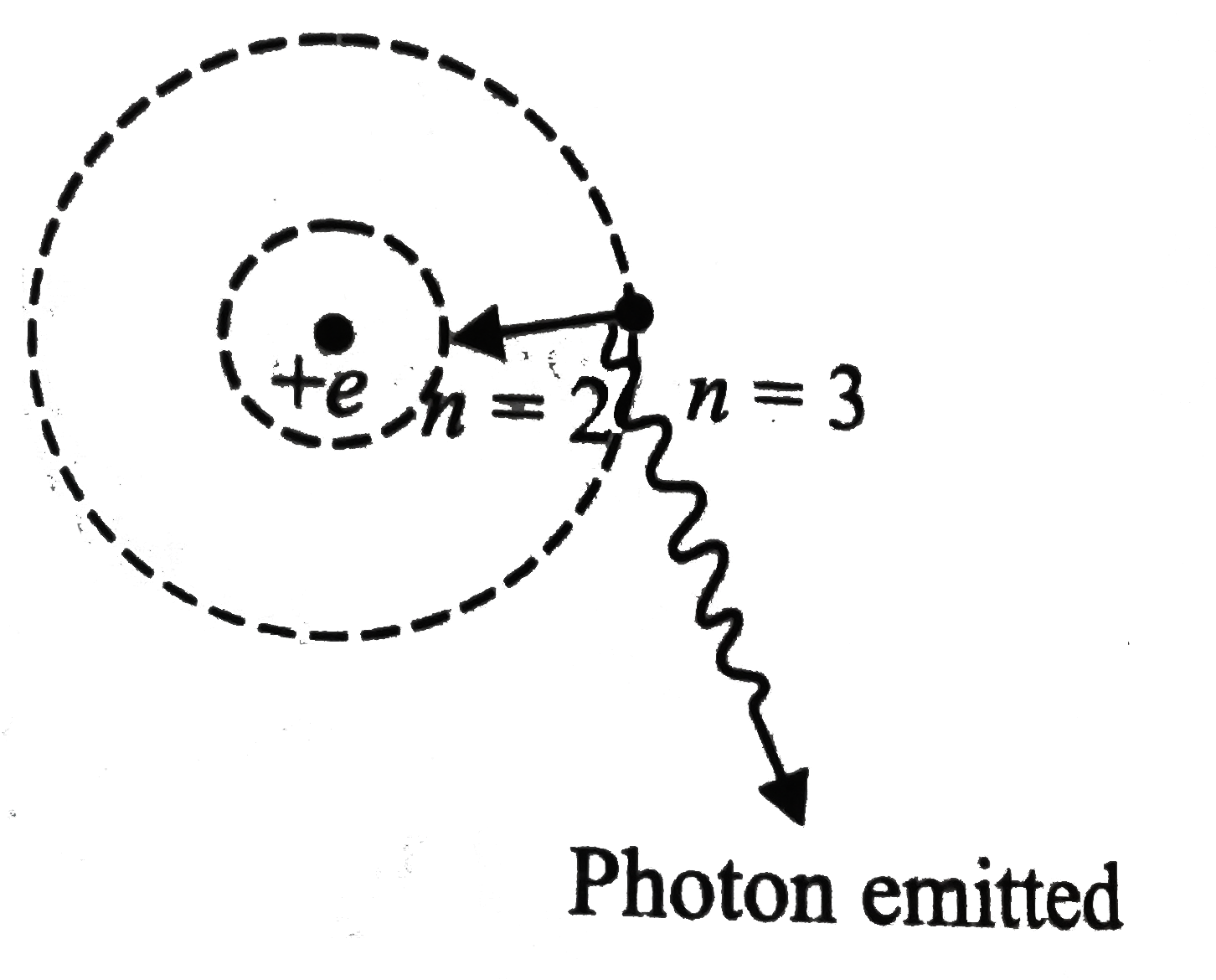A single electron ion has nuclear chrage +Ze where Z is atomic number and e is electronic charge. It requires 16.52eV to excite the electron from the second Bohr orbit to third Bohr orbit. Find
(a) The atomic number of element?
(b) The energy required for transition of electron from first to third orbit?
(c ) Wavelength of photon required to remove electron from first Bohr orbit to infinity?
(d) The kinetic energy of electron on first Bohr orbit?
The correct Answer is:(a) Z=3, (b) 108.8eV, (c) 1.013×10−8m, (d) 122.4eV
(a) 16.52=(E3−E2)×Z2
16.52=1.89×Z2⇒Z2=9orZ=3
(b) (E3−E1)z=12.09×Z2=12.09×9=108.81eV
(c ) λ=12400ΔE1tp∞=1240013.6×32=101.3Å=1.013×10−8m,
(d) KE1=13.6Z2eV=13.6×32=122.4eV
Topper's Solved these Questions
- BOOK - RESONANCECHAPTER - NUCLEAR CHEMISTRYEXERCISE - PART -II32videos
NUCLEAR CHEMISTRY
- BOOK - RESONANCECHAPTER - NUCLEAR CHEMISTRYEXERCISE - Exercise-225videos
NUCLEAR CHEMISTRY
- BOOK - RESONANCECHAPTER - NUCLEAR CHEMISTRYEXERCISE - Board Level Exercise39videos
NUCLEAR CHEMISTRY
- BOOK - RESONANCECHAPTER - NITROGEN CONTAINING COMPOUNDSEXERCISE - ORGANIC CHEMISTRY(Nitrogen containing Compounds)30videos
NITROGEN CONTAINING COMPOUNDS
- BOOK - RESONANCECHAPTER - P BLOCK ELEMENTSEXERCISE - PART -II24videos
P BLOCK ELEMENTS
Similar Questions
A single electron orbits around a stationary nucleus of charge +Ze, where Z is a constant and e is the magnitude of the electronic charge. It requires 47.2eV to excite the electron from second Bohr orbit to the third bar Bohr orbit. Find :
(a) the value of Z,
(b) the energy required to excite the electron from n=3 to n=4.View SolutionA single electron orbits around a stationary nucleus of charge +Ze, where Z is a constant and e is the electronic charge. It requires 47.2eV to excited the electron from the second Bohr orbit to the third Bohr orbit. Find (i) the value of Z, (ii) the energy required to excite the electron from the third to the fourth Bohr orbit and (iii) the wavelength of the electromagnetic radiation radiation to remove the electron from the first Bohr orbit to infinity.
View Solution
Knowledge Check
- Question 1 - Select One
A single electron atom has a nuclear charge +Ze where Z is the atomic number and ‘e’ is the electronic charge. It requires 47.2ev to excite the electron from 2nd Bohr's orbit to 3rd Bohr's orbit from above given data solve the following question :
In the hydrogen atom, if the reference level of potential energy is assumed to be zero at the ground state level. Choose the ncorrect statement.AThe total energy of the shell increases with increase in the value of nBThe total energy of the shell decrease with increase in the value of n.CThe difference in total energy of any two shells remains the same.DThe total energy at the ground state becomes 13.6 eV.
A single electron orbits around a stationary nucless of charge +Ze where Z is a constant and e is the magnitude of electronic charge ,if respuires 47.2 e

is excite the electron from the second bohr orbit to the third bohr orbit
a. Find the value of Z
b. Find the energy required to the electron from n=3 ton=4
c. Find the wavelength of radiation to remove the electron from the second bohr orbit to infinity
d. Find the kinetic energy potential energy and angular momentum of the electron in the first orbit
Find the ionination energy of above electron system in electronvalt.View SolutionA single electron orbikt around a stationary nucleus of charge +Ze when Z is a constant and e is the magnitube of the electronic charge if 47.2eVexcitethee≤ctronomthesecondbohrorbit→thethirdbohhrorbitf∈al<br>(i)ThevolueofZ<br>(ii)Tyhee≠rgyrequiredtoνc≤usthee≤ctronomthethird→thefourthbohrorbit<br>(iii)Thewave≤n>hofthee≤ctronmag≠ticradiationrequired→removethee≤ctronomthefirstbohrorbit→∈l∈ity<br>(iv)Thee≠rgypotentiale≠rgypotentiale≠rgyandtheanga––rmomentumofthee≤ctron∈thefirstbohrorbit<br>(v)Theradiusofthefirstbohrorbit(Theionizatione≠rgyofhydro≥na→m = 13.6 eV bohrradius= 5.3 xx 10^(-11) matrevelocityoflight= 3 xx 10^(8) m//secplanks'sconstant = 6.6 xx 10^(-34) jules - sec )
View SolutionAn electron is placed in an orbit about a nucleus of charge +Ze. It requires 47.2 eV energy to excite an electron from second Bohr orbit to third Bohr orbit. What is the value of Z?
View SolutionA single electron orbits around a stationary nucleus of charge +Ze. It requires 47.2 eV to excite the electron from the 2nd to 3rd Bohr orbit. Find atomic number 'Z' of atom .
View SolutionA single electron orbits a stationary nucleus of charge +Ze, where Z is a constant and e is the magnitude of electronic charge . It requires 47.2eV to excite . Find
a the value of Z
b the energy required to excite the electron from the third to the fourth Bohr orbit.
the wavelength of electromagnetic rediation required to remove the electron from the first Bohr orbit to infinity.
d Find the KE,PE, and angular momentum of electron in the first Bohr orbit.
the redius of the first Bohr orbit
[The ionization energy of hydrogen atom =13.6eV Bohr radius =5.3×10_11m, "velocity of light" =3×10−8jms−1, Planck's constant =6.6×10−34j−s]View SolutionAn energy of 68eV is required to excite a hydrogen like atom from its second Bohr orbit to the third. The nuclear charge is Ze. Find the value of Z, the kinetic energy of the electron in the first Bohr orbit and the wavelength of the radiation required to eject the electrons from the first Bohr orbit to infinity.
View SolutionWhat is the energy required to remove an electron from second orbit of hydrogen atom ?
View Solution

